Everything you Need to Know About Terrazzo Flooring

Just like in the world of fashion, old decor trends almost always come back into style eventually. Terrazzo flooring is a great example of this. In this article, we’ll tell you everything you need to know.
Terrazzo is a popular material in the world of interior decor. It is often used for making large sections of flooring, but is also commonly used for elements such as walls, counters, and shelves.
Its triumphant return is undoubtedly down to its amazing ability to adapt to almost any space. This versatile material will add a touch of elegance and originality to any room, giving it a splash of extra color and energy.
What is terrazzo?
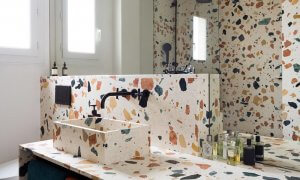
You’ve probably seen this material many times before, especially in places like shopping malls. But what exactly is terrazzo? Terrazzo is made up of small fragments of lots of different materials such as marble, glass, stone or granite, which are held together by mortar.
Nowadays, making terrazzo is a fairly complex process, and manufacturers use a variety of different materials. However, it started out with far simpler origins. The earliest record of terrazzo dates back to 16th Century Italy. Initially, it was made from fragments of marble that had been left over from other constructions.
While the original techniques remain the same, the process has been complicated by the incorporation of new materials. Because you can personalize the colors and patterns, terrazzo offers up an endless range of design possibilities, and can adapt to any style.
The elegance of terrazzo flooring
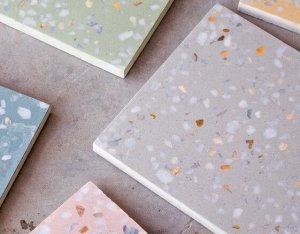
Terrazzo flooring is a great choice if you want to put the focal point of your decoration on the colors. The originality of the designs allows you to create a unique space that is as elegant as it is daring.
Because you can choose both the materials and the colors, the range of options is almost endless. Choosing terrazzo means you’ll have a unique floor, of which the color pallet is the undeniable star.
This element is a fantastic way to add a softer touch to a cold, modern space, adding a certain visual warmth. It is also a great material if you want to give your room a slightly vintage feel.
The durability of terrazzo
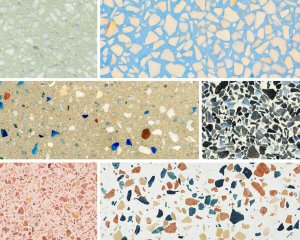
Another of the main advantages of terrazzo flooring is its great durability. Nowadays, you can find terrazzo floors that date back over a hundred years. This material is so hard-wearing, that they still look as good as new.
This characteristic has made it one of the most popular materials for public spaces, where the flow of people is endless.
Its great strength is a result of mixing stone and glass chips with resin and mortar. Plus, because it doesn’t have one, solid color, scratches can easily be camouflaged.
Terrazzo flooring: easy to clean
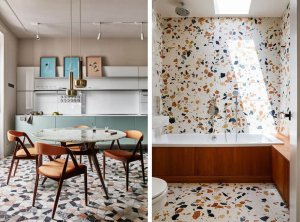
Terrazzo is also one of the easiest materials to clean. Thanks to its speckled appearance and the use of a strong binding agent, it is very difficult to scratch or stain. Plus, the sealant they use to finish these floors makes it impermeable.
As a result, you won’t need to use chemical products to clean your terrazzo floors, which, aside from being expensive, can also be bad for your health. A little water with some pH neutral soap should be more than enough to keep them sparkling.
Terrazzo flooring: a sustainable material
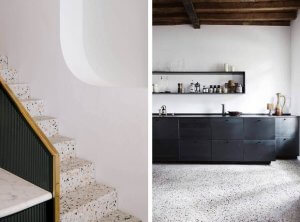
These floors are made from chips of stone, glass, marble or porcelain, which have bee extracted and recycled from other constructions. This reduces waste, and is less damaging for the environment.
Plus, once installed, terrazzo is finished with a strong sealant. This prevents allergens from sticking to the material, and stops it from developing mold, making it one of the safest materials for your health.
Terrazzo is a great option for your home, not just because of its decorative potential, but also because of its great durability, and environmentally-friendliness.
Just like in the world of fashion, old decor trends almost always come back into style eventually. Terrazzo flooring is a great example of this. In this article, we’ll tell you everything you need to know.
Terrazzo is a popular material in the world of interior decor. It is often used for making large sections of flooring, but is also commonly used for elements such as walls, counters, and shelves.
Its triumphant return is undoubtedly down to its amazing ability to adapt to almost any space. This versatile material will add a touch of elegance and originality to any room, giving it a splash of extra color and energy.
What is terrazzo?

You’ve probably seen this material many times before, especially in places like shopping malls. But what exactly is terrazzo? Terrazzo is made up of small fragments of lots of different materials such as marble, glass, stone or granite, which are held together by mortar.
Nowadays, making terrazzo is a fairly complex process, and manufacturers use a variety of different materials. However, it started out with far simpler origins. The earliest record of terrazzo dates back to 16th Century Italy. Initially, it was made from fragments of marble that had been left over from other constructions.
While the original techniques remain the same, the process has been complicated by the incorporation of new materials. Because you can personalize the colors and patterns, terrazzo offers up an endless range of design possibilities, and can adapt to any style.
The elegance of terrazzo flooring

Terrazzo flooring is a great choice if you want to put the focal point of your decoration on the colors. The originality of the designs allows you to create a unique space that is as elegant as it is daring.
Because you can choose both the materials and the colors, the range of options is almost endless. Choosing terrazzo means you’ll have a unique floor, of which the color pallet is the undeniable star.
This element is a fantastic way to add a softer touch to a cold, modern space, adding a certain visual warmth. It is also a great material if you want to give your room a slightly vintage feel.
The durability of terrazzo

Another of the main advantages of terrazzo flooring is its great durability. Nowadays, you can find terrazzo floors that date back over a hundred years. This material is so hard-wearing, that they still look as good as new.
This characteristic has made it one of the most popular materials for public spaces, where the flow of people is endless.
Its great strength is a result of mixing stone and glass chips with resin and mortar. Plus, because it doesn’t have one, solid color, scratches can easily be camouflaged.
Terrazzo flooring: easy to clean

Terrazzo is also one of the easiest materials to clean. Thanks to its speckled appearance and the use of a strong binding agent, it is very difficult to scratch or stain. Plus, the sealant they use to finish these floors makes it impermeable.
As a result, you won’t need to use chemical products to clean your terrazzo floors, which, aside from being expensive, can also be bad for your health. A little water with some pH neutral soap should be more than enough to keep them sparkling.
Terrazzo flooring: a sustainable material

These floors are made from chips of stone, glass, marble or porcelain, which have bee extracted and recycled from other constructions. This reduces waste, and is less damaging for the environment.
Plus, once installed, terrazzo is finished with a strong sealant. This prevents allergens from sticking to the material, and stops it from developing mold, making it one of the safest materials for your health.
Terrazzo is a great option for your home, not just because of its decorative potential, but also because of its great durability, and environmentally-friendliness.
All cited sources were thoroughly reviewed by our team to ensure their quality, reliability, currency, and validity. The bibliography of this article was considered reliable and of academic or scientific accuracy.
- Jiménez, E. C.: Limpieza, tratamiento y mantenimiento de suelos, paredes y techos, Madrid, Elearning, 2014.







